Cocker Spaniel vs. Golden Retriever Breed Guide – What Is The Best Breed For You

Neither of these breeds is rare, so they are available.
However, you want to make sure that you purchase your dog from a reputable breeder. When you buy from a reputable breeder, then health problems are lessened. There is also other helpful information below in this article.
Key Similarities
Both of these breeds can be full of energy, but they can also be couch potatoes if the opportunity is given to them.
The Cocker Spaniel and the Golden Retriever breeds both love water. So if there is a pool or a pond present, most likely, that is where they’ll be.
These breeds are family dogs, love kids, and enjoy being involved in family activities.
Key Differences
The Golden Retriever weighs between 55 to 75 pounds, while the Cocker Spaniel is only between 25 to 25 pounds. In addition, the Golden Retriever is taller at 21-24 inches than the smaller 15-17 inches tall Cocker Spaniel.
The Golden Retriever sheds profusely and can be brushed 3 times a day to keep it under control. The Cocker Spaniel sheds considerably less and needs less grooming than a Golden Retriever.
Both can have dental issues, but the Cocker Spaniel will need his teeth cleaned more frequently.
Pros of Owning a Cocker Spaniel
Cocker Spaniels love to play fetch and are good with children. This breed can get enough exercise from one or two walks a day.
If the Cocker Spaniel is raised from puppyhood in an apartment, he will adapt quickly to apartment life.
The upkeep of a Cocker Spaniel is less because he eats less. Plus, groomer visits are less frequent.
Pros of Owning a Golden Retriever
Golden Retrievers are alert, friendly, and loving dogs. The breed will bark when alarmed but aren’t great at guarding.
Golden Retrievers are playful and intelligent dogs and are good with children.
Who Should Own a Cocker Spaniel?
First time owners, apartment dwellers, people with kids, seniors.
Who Should Own a Golden Retriever?
First time owners, homeowners with fenced-in yards, people with kids
All About the Cocker Spaniel
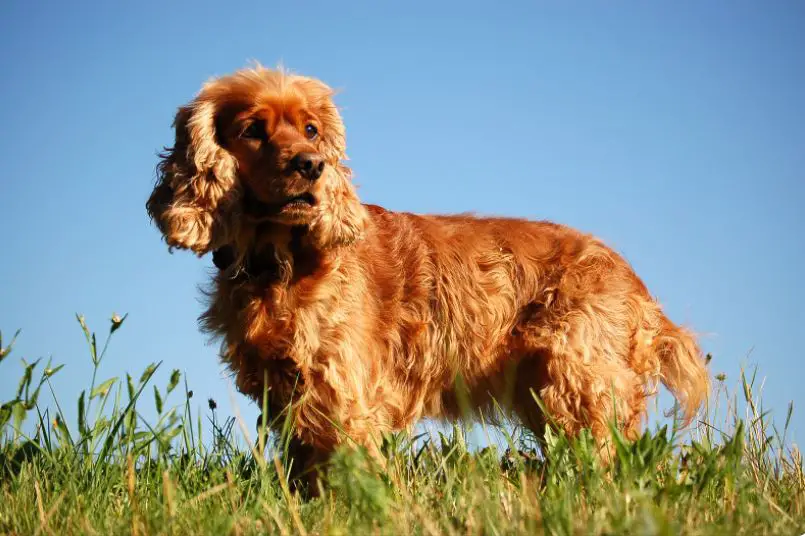
The Cocker Spaniel is descended from the Spaniel, one of the oldest dog breeds. The Spaniel breeds came from Spain and were all sizes and shaped.
The types of spaniels were land, water, springer, field spaniels, and Sussex.
All About the Golden Retriever
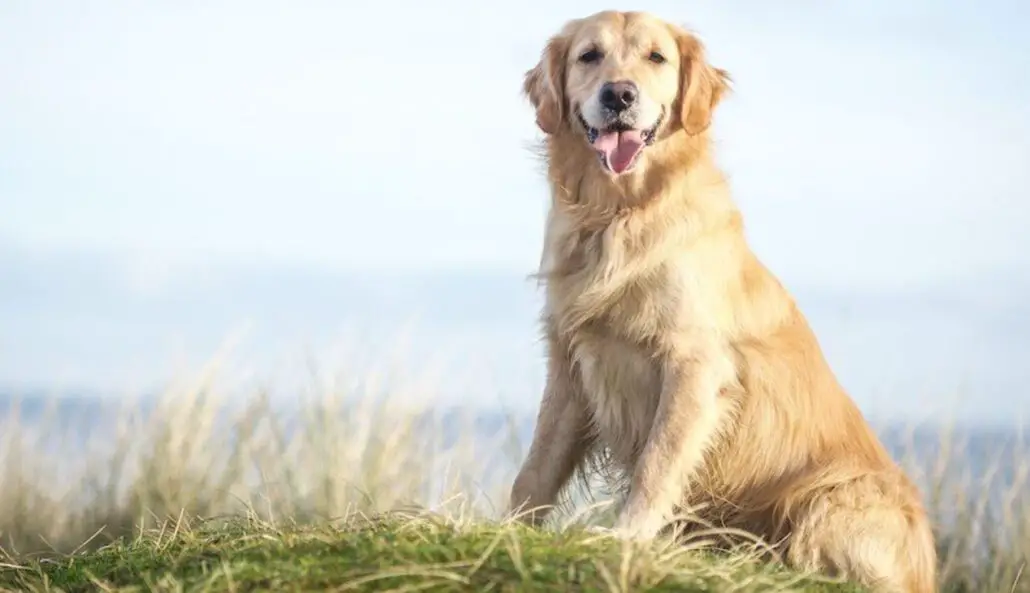
The Golden Retriever came from Scotland and originated in the 1800s. The breed was designed for hunting ducks and waterfowl.
Golden Retrievers are excellent hunting dogs but are wonderful family dogs as well.
History:
The Spaniel breeds came from Spain and were all sizes and shaped. The types of spaniels were land, water, springer, field spaniels, and Sussex.
All of these spaniels were bred for different hunting duties. The dog’s size was the main point of difference between all these dogs.
The Cocker Spaniel was used to retrieve and flush out small game such as woodcock, pheasant, and quail. In 1946, both the American Cocker Spaniel and the English Cocker Spaniel were recognized officially by the AKC as separate breeds.
Size and appearance:
Cocker Spaniels have incredibly expressive faces and stand out in a crowd. However, their tail keeps wagging, their eyes are dark, and big floppy ears.
Your Cocker Spaniel’s weight will be between 24-28 pounds, with the male being 15 inches at the withers and the female being 14 inches. The head is graceful and round with a broad square muzzle. The ears are feathered long, and the dog’s back slopes towards the tail. There is feathering on the ears and the legs, underside, and chest. Most of the time, the tail is docked.
There are a variety of colors with Cocker Spaniels. The colors can be solid black, tan, or red. Other coats are bi-colored and tri-colored. The coats can be black and white, black and tan, or black and white with tan flecks.
The AKC has the Cocker Spaniel divided into three varieties for show. The divisions are parti-color, black, or ASCOB, which stands for Any Solid Color Other Than Black.
Lifespan:
The life expectancy of your Cocker Spaniel is between 14 to 16 years.
Guard dog or family pet?
The guarding instinct is very low in this breed.
You can train them to bark when someone is at the door, but that’s about it. These dogs are friendly, gentle dogs who make great family pets.
History:
The British lords in Scotland loved hunting and needed an excellent hunting dog.
So, the Golden Retriever was bred for that purpose. But these dogs are also well-behaved and naturally friendly, so they have become known as family-friendly dogs.
Size And Appearance:
These are large dogs between 20 to 25 inches in height and 55 to 75 pounds in weight.
Their coat is either straight or wavy, with the color being Golden, Light Golden, or Dark Golden.
Goldens move with a powerful, smooth gait with a feathery tail carried high. Heavy feathering is also across their chest, the backs of the dog’s legs, and the tail.
These dogs can be leaner and sporty or broad and denser in their physique.
Lifespan:
A Golden Retriever’s life span is between 10 to 12 years.
Guard Dog Or Family Pet:
A Golden Retriever can make a good guard dog. Because this breed isn’t naturally aggressive, though, it may require some training.
Also, since a Golden Retriever is a large dog, they can look very intimidating.
Because this breed is an intelligent breed, they can be taught to be a guardian for you and your family.
They know when something is wrong or when someone means to harm the family members. Because they are such loyal dogs, Golden Retrievers won’t run away when danger threatens.
But the downside is that Golden Retrievers aren’t barkers, so your dog may not alert you to the fact that there’s an intruder right away.
Plus, because being friendly is in its nature, the dog is more likely to stand behind you, not in front of you, if he isn’t trained to do so.
Basically, Golden Retrievers are family dogs but can be trained to be guard dogs if used with the command technique.
Cocker Spaniel In More Detail
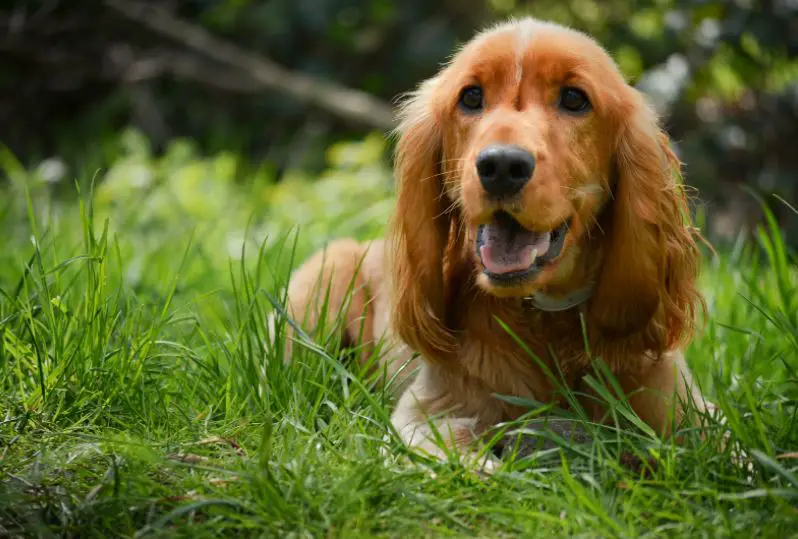
Temperament And Behavior:
The Cocker Spaniel breed is easy-going, affectionate, gentle, but lively. These dogs are good with children and usually non-aggressive toward other people and pets.
However, the Cocker Spaniel became one of the most sought-after dogs due to its popularity. This has led to problems within the breed. Backyard breeders and puppy mills have overbred Cocker Spaniels. This has resulted in negative characteristics and genetic problems from unscreened stock.
Always purchase your puppy from a reputable breeder who can show you the profile of the parents and grandparents.
Training and obedience:
The reports on training and housebreaking are mixed. Some owners say that the breed is easy to train. On the other hand, some owners say that the dogs are obedient but stubborn when housebreaking.
Your pet will be sweet, playful, and gentle with kids and other animals when properly socialized. These dogs love to play fetch and love to play games. Your dog will bond closely with you and your family members and will want to be with you all the time.
Exercise Needs:
Your Cocker Spaniel will need to be taken on daily long walks to wear down his stamina. If you live in an apartment, your pup will do fine as long as he is exercised. If you have a fenced-in yard, that’s even better because he will be able to run around and explore.
Shedding, grooming, and maintenance:

These dogs have beautiful silky hair with a dense double coat. Your dog will shed moderately, and if you keep his coat long, you’ll have to brush it at least every other day.
In addition, some professional grooming will be needed to keep the coat in shape.
When walking your pup, try to avoid burrs and thickets, which can become embedded in your dog’s coat and cause significant issues. Many breeders and professional groomers recommend the “puppy cut” because it requires less maintenance.
Wipe under your dog’s eyes often because tearing is a problem and will leave brown streaks. This breed tends to develop ear infections because of floppy ears. Clean the ears with a cotton ball and a vet-approved ear wash. Don’t use a Q-tip because you could push the debris further into the ear and damage it.
Health issues:
Be careful not to overfeed your dog because Cockers love to eat. Overeating can cause a condition called bloat, with can be dangerous. In addition, your pet can develop various skin issues, progressive retinal atrophy, glaucoma, cataracts, luxating patella, hemolytic anemia, heart problems, kidney failure, hip dysplasia, and epilepsy.
It’s essential to check the valid veterinary screening certificate for both parents and grandparents. This will give you a medical history of the dog’s family and what conditions could be prevalent. Again, a professional breeder will have this information on hand to show you.
Quick Facts:
The name “cocker” comes from the word woodcock, a game bird the dogs were used for flushing out of the bushes.
The average litter of puppies is 5 but can be anywhere from 1 to 7.
Cocker Spaniels loves to swim and tracks ascent with his nose down and tail wagging.
Golden Retrievers In More Detail
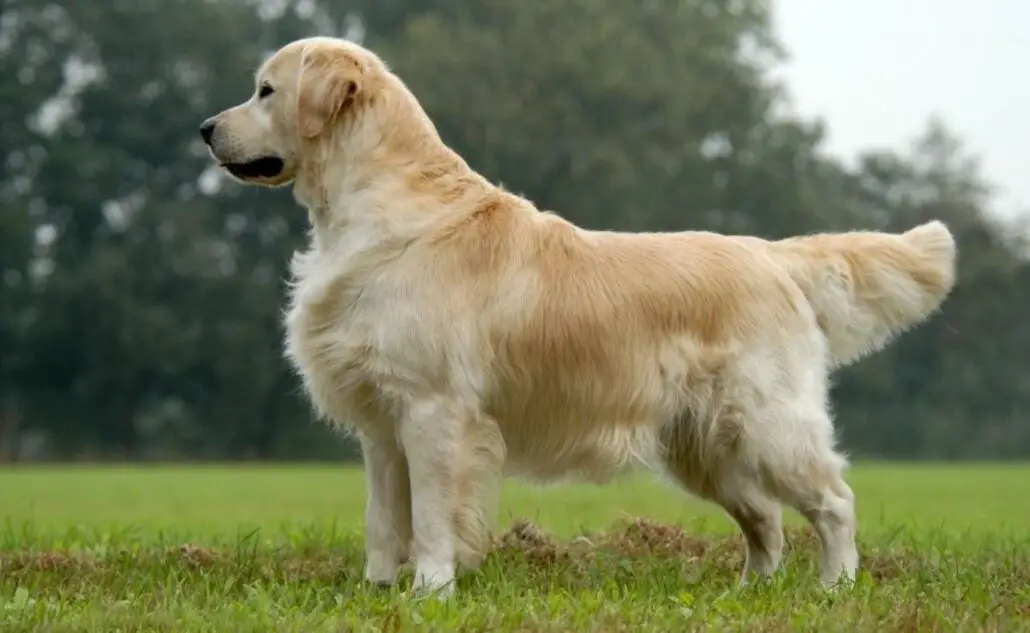
Temperament And Behavior:
Golden Retrievers are naturally well-behaved and friendly. Their temperament is playful, gentle, and outgoing. Plus, this breed is intelligent and devoted to its family.
A Golden Retriever gets along with other animals. However, these dogs do exuberant jumps on people when young. Plus, this breed does tend to mouthiness and likes to carry things around.
Training and obedience:
A Golden Retriever has a puppy frame of mind until he is over three years old. Early training is essential so you can instill good manners and calmness.
Even if he is eager to please, your dog will be distracted by the wonderful new sights and smells, so patience is a must.
Exercise Needs:
These dogs are from the sporting class, so they need exercise. If your dog can’t vent his energy and you find him interesting things to do, then he’ll find them. This breed has an extremely high energy level and a high exercise level.
An hour of exercise at least will help keep your dog’s exuberance under control. After that, your dog will love to retrieve stuff and bring back just about anything thrown to him.
Shedding, grooming, and maintenance:
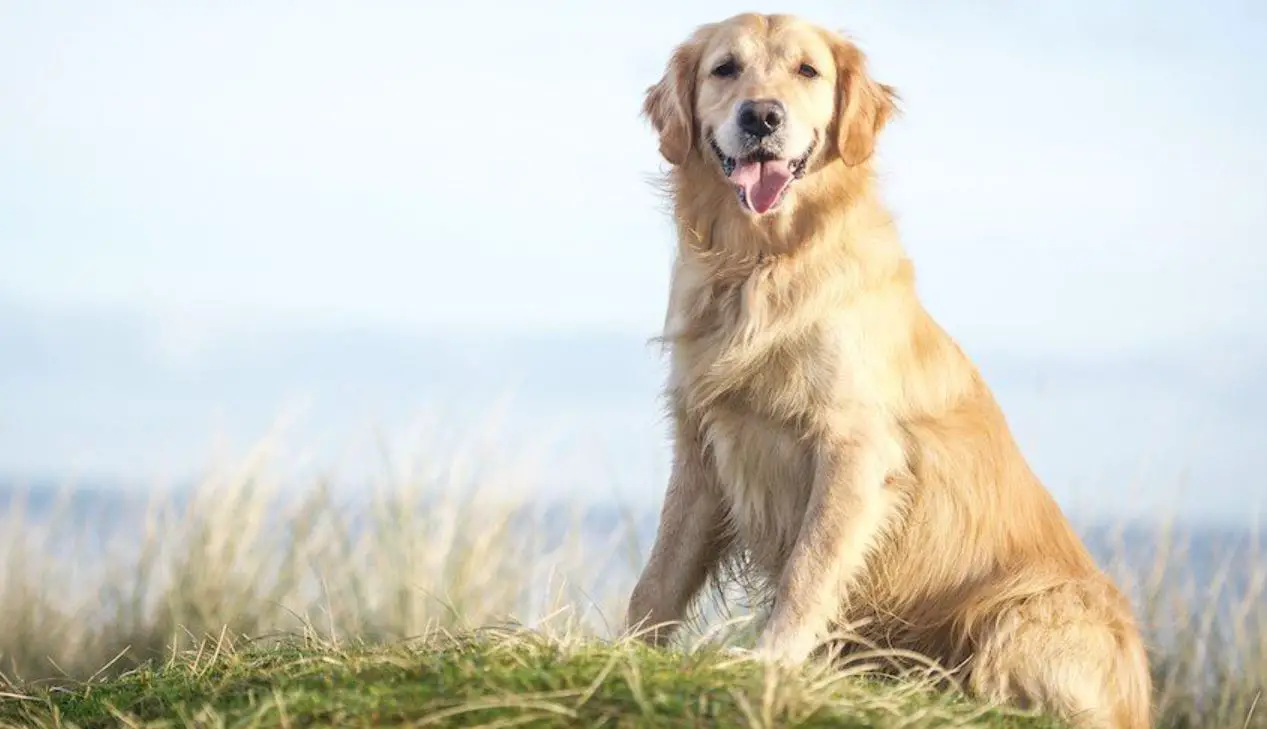
Golden retrievers shed a lot and often. They require regular brushing to keep ahead of the hair shedding.
Because the breed is a hunting and waterfowl dog, the outer coat is dense and will repel water.
You will regularly need to brush and comb your dog to avoid his coat getting matted and tangled. Some dogs of this breed have a medium-length coat that isn’t as hard to groom. Other dogs have a heavier coat with lots of feathering.
Plus, Goldens need to be clipped and scissored occasionally, so a trip to the groomers may be necessary to keep your dog sanitary. Keeping nails trimmed is also a part of the grooming. These dogs shed moderately in the winter and summer but heavily in the spring and fall.
Because this breed has fold-over ears, they are prone to ear infections. The ears create an environment for bacteria and fungus to grow. It appears as black dirt-looking particles with a terrible odor. Simply gently wipe the outer ear with a cotton ball that’s been dampened with pH-balanced ear cleaner.
Health issues:
Golden Retrievers are prone to cancer, heart problems, skin allergies, eye defects. Plus, they gain weight easily, so overfeeding should not be done. In addition, they are susceptible to bloat, hypothyroidism, and hip dysplasia.
Quick Facts:
These dogs have a distinctive doggy odor and produce a lot of dander.
The breed is a good match for children, other dogs, cats, families, and seniors. They are excellent dogs for first-time pet owners, and these dogs love water.
The cost of a Golden Retriever is about $500.


